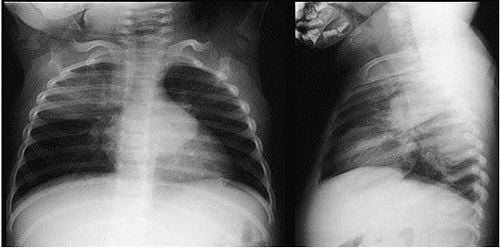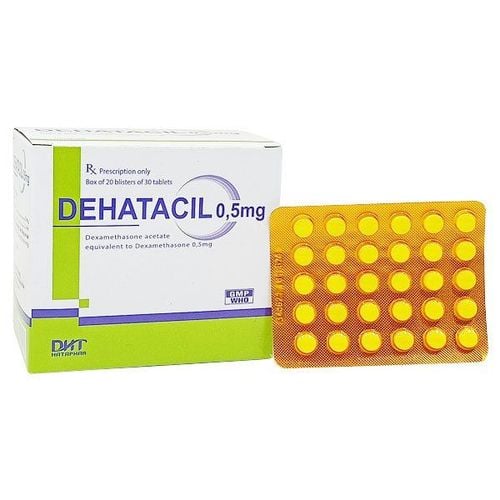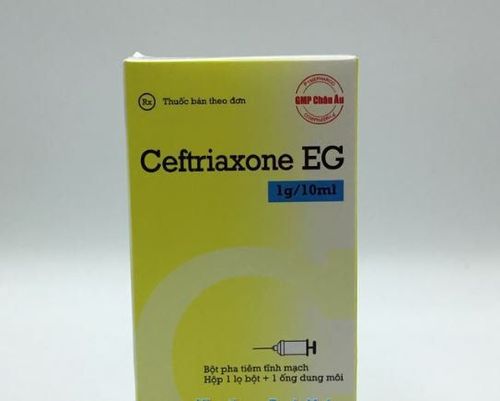This is an automatically translated article.
This article is professionally consulted by Master, Resident Doctor Dang Thi Ngoan - Pediatrician - Neonatologist - Department of Pediatrics - Neonatology - Vinmec Ha Long International Hospital.Delay in making a diagnosis of neonatal purulent meningitis will affect the child's life. Therefore, in addition to relying on clinical symptoms, diagnostic tests also contribute significantly to the treatment orientation and prognosis of neonatal meningitis.
1. Lumbar puncture
Lumbar puncture is indicated for the investigation of CSF in all neonates when sepsis or meningitis is suspected, even in the absence or complete absence of neurologic findings. . This is an invasive procedure, using a needle inserted into the space between the vertebrae to extract some cerebrospinal fluid – a type of fluid that connects to the fluid in the ventricular cavity.
Performing a lumbar puncture still has some complications such as: Brain stem hernia, infection from outside...
Meningitis is inherently a disease that will increase the risk of death in newborns . If combined with CSF results, disease prognosis will be more clearly oriented. In addition, there are also many cases of neonates with negative blood cultures while having a positive CSF culture. This suggests that the diagnosis of meningitis can be missed if the exclusionary evidence is not thought through and collected.
In the case of bacterial meningitis, repeat lumbar puncture 24 to 48 hours after initiating treatment to ensure eradication of CSF and to assess antimicrobial efficacy born. In addition, it should be noted that the analysis of CSF results in neonates will be much different than in older children, especially in premature infants due to the high blood-brain barrier with high permeability. , causing physiologically higher than normal glucose and protein levels.

Chọc dò tủy sống trẻ sơ sinh
2. Test for the agent
The causative agent of neonatal purulent meningitis is relatively diverse and can only be identified by specialized tests.
The polymerase chain reaction (PCR) test is a powerful diagnostic tool with near absolute sensitivity and specificity. This means allows the determination of group B streptococcal antigens in the cerebrospinal fluid and also in the urine when the body is infected. At the same time, this is also the criterion for the determination of herpes simplex virus (HSV) and enterovirus agents in the cerebrospinal fluid. In neonates, PCR has a sensitivity of 71-100% and a specificity of approximately 98-99%. In addition, if HSV PCR in CSF is initially negative and HSV meningitis is still suspected, lumbar puncture will need to be repeated 5-7 days later.
Besides, rapid screening with urine latex agglutination test kit can be done for E coli, Streptococcus pneumoniae and group B streptococcal.
In case the child has skin blisters , the investigation of HSV infection should also be done by culturing the fluid from these vesicles. Not only that, swabs of the nasopharynx, conjunctiva and rectum have also been used to identify viral pathogens.

Xét nghiệm chuyên biệt tìm tác nhân gây bệnh
3. Magnetic resonance imaging
Magnetic Resonance Imaging (MRI) is a reliable method to examine the structures of the nervous system as well as to determine the cause of infection and complications of infarction, secondary bleeding. development, cerebral edema, hydrocephalus or abscess formation.This means should be considered in the setting of focal neurological deficits accompanied by persistent uncontrollable infection. At this point, subdural lesions are best diagnosed with MRI. Several studies have documented periventricular white matter abnormalities on MRI in neonates as supporting evidence for the diagnosis of neonatal meningitis.
At the same time, the MRI scan will also be useful to monitor the progression of the infection, contributing to the prognosis of the disease. In advanced centers, the spectroscopic function of magnetic resonance imaging can provide important additional information about the metabolic processes in the brain parenchyma of the neonate.
4. Other visual media
4.1 Computerized tomography Although computed tomography (CT) does carry a risk of radiation exposure on the newborn brain, as it can be performed much more quickly and easily than an MRI , this imaging tool will also help in decision-making in general neurosurgical interventions, such as ventricular drainage or abscess removal.
4.2 Transcranial Ultrasound This tool also allows for alternative imaging studies in critically ill neonates. However, the limitation of transcranial ultrasound is that it does not provide details of the structures in the brain parenchyma. Nevertheless, it remains a low-risk means and is also useful in monitoring the ventricular size in hydrocephalus that can occur during the acute phase of meningitis.
4.3 Chest X-ray The images of the lung parenchyma and the heart shadow will be examined simply by taking a chest X-ray. Meningitis or sepsis may occur concurrently with pneumonia. On the other hand, radiographs are sometimes indistinguishable from abnormalities in the pathology of surfactant deficiency in premature infants, pulmonary hypertension, and congenital heart disease.

X-quang phổi giúp chẩn đoán bệnh
5. Electroencephalogram
Electroencephalogram (EEG) is not an essential test in the initial diagnosis when neonatal meningitis is suspected. However, in neonates with meningitis unresponsive to anticonvulsants or convulsions presenting with respiratory arrest and bradycardia, EEG monitoring provides useful information to guidelines for treatment with appropriate classes of anticonvulsants.
EEG also has a role in disease prognosis. Infants with normal or only mildly abnormal EEGs have better outcomes, while infants with moderate to severe EEG abnormalities are more likely to die or have a poor outcome. in the long term.
In summary, with the popularity of testing facilities, the diagnosis of meningitis today has become more convenient. As a result, as long as the doctor thinks about this diagnosis and prescribes the appropriate laboratory, many more newborns will receive the right treatment, improving the future outcome.

Điện não đồ trẻ nhỏ
Pediatrics department at Vinmec Health System with the function of receiving, examining and actively treating diseases that children often get. With strengths in examination - detection - early intervention in cases of high risk of abnormalities in the development of children.
Doctor Dang Thi Ngoan used to be a lecturer in the Department of Pediatrics - Hai Phong University of Medicine and Pharmacy. Having been granted certificates in Pediatrics at home and abroad such as: Westmead Hospital, Australia; Hai Phong Medical University. Currently, Doctor Ngoan is a pediatrician - neonatologist at the Department of Neonatology at Vinmec Ha Long International Hospital.
Customers can directly go to Vinmec Health system nationwide to visit or contact the hotline here for support.
SEE ALSO:
Function of CSF Meaning and application of CSF test Learn about cerebrospinal fluid test to find the cause of headache














